Our 5 Favorite WordPress Plugins for Marketing
WordPress plugins have been shaping the way users extend WordPress for years. As plugin development evolves, it is essential to understand why—and when—you should use plugins. While plugins do help extend functionality, you need to be aware of the added weight that plugins can add to your website, as well as any vulnerabilities they may have.
What to Look For When Choosing Plugins
As you browse through the WordPress Plugin Repository, you will notice that all plugins have three items right off the bat:
- Reviews (star rating, and count)
- Number of active installations
- The version of WordPress the plugin has been tested for
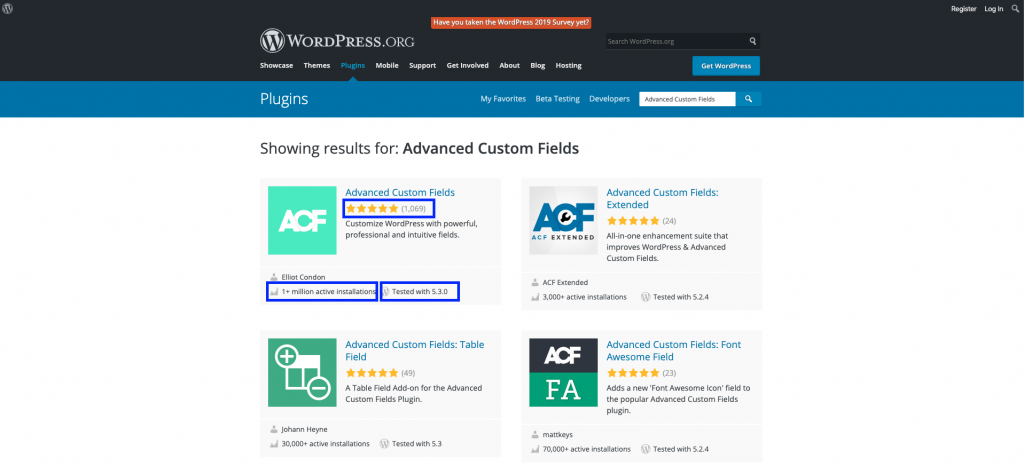

Reviews
Reviews can make or break a plugin’s reputation. It is important to read through the reviews because often, the users submitting them will also provide small use cases for the plugin, which is a good way for you to see if the plugin is going to work for you. It also allows you to see if any bugs have been identified, and whether or not the plugin developer is actively working to resolve them. Sometimes reviews can be misleading as well; some people do not read instructions before downloading and encounter trouble implementing the plugin, which in turn can result in a bad review.
Number of Active Installations
In many cases, the number of active installs can be a great indicator of whether or not the plugin works as intended. However, It can also be misleading because some new plugins may not have enough traction (yet) compared to others that have been around for a long time. Checking the reviews and changelog for new plugins can help make sure it is going to be sufficient for your use.
WordPress Version Testing
The WordPress version for which the plugin has been tested is probably the most important deciding factor when choosing plugins. With updates for WordPress being pushed monthly, plugin compatibility can vary depending on the version of WordPress your website is on, versus the version of WordPress your plugin has been tested with. At the time that this post was written, WordPress is currently on version 5.3, which means that your plugins should have at least been tested through version 5+.
Testing Plugins
When it comes to building and maintaining websites, it is best practice to test before implementing changes to a live site. Here are a few ways you can test your plugins to check for functionality and potentially save you many headaches down the line.
Create a Dev/Test Site (Easy)
Most WordPress-specific hosting plans will allow you to create multiple websites on your server. If you aren’t sure, it would be a good idea to reach out to your hosting support to inquire about setting up an additional test site to serve as a copy of your live site.
Create a Local Site (Advanced)
For advanced WordPress users, here is a great step-by-step tutorial on how to create a local WordPress install. A local install is a website that is hosted locally on your own computer, whereas a dev, test, or live site is hosted on a remote server.
Too Many Plugins?
While plugins are a vital part of any WordPress site, it is important to remember that it can be detrimental to have too many. When uploading plugins, you are adding additional weight to your website, which can negatively affect your site speed.
It is always good practice to plan your website’s structure before you start building it. That way, you will know ahead of time what features or functionality will require a plugin, as well as what could be done with a smaller, custom implementation. Utilizing a developer to create a custom implementation offers a solution that won’t contain all of the bloating that can come from using plugins.
WordPress Plugins We Use
There is no shortage of available WordPress plugins. Below are some of our favorites that we use at Portent.
Advanced Custom Fields
Advanced Custom Fields (ACF) is a WordPress plugin that is used by developers to create easy to use content fields inside of edit pages, like the Page(s) section in WordPress.
The ‘content fields,’ more commonly known as ‘custom fields,’ can be used for nearly anything. Custom fields are defined in the plugin settings, and a developer will be required to configure the code, which would then output the field content to the front end of the website. By utilizing the power of ACF, you can construct websites faster, and make content entry much easier.
Why We Use ACF
ACF is our favorite plugin here at Portent; we use it on nearly all of the WordPress sites we work on. It is great for creating page builders, adding additional functionality to custom post types, and creating custom logic for all sorts of different website features.
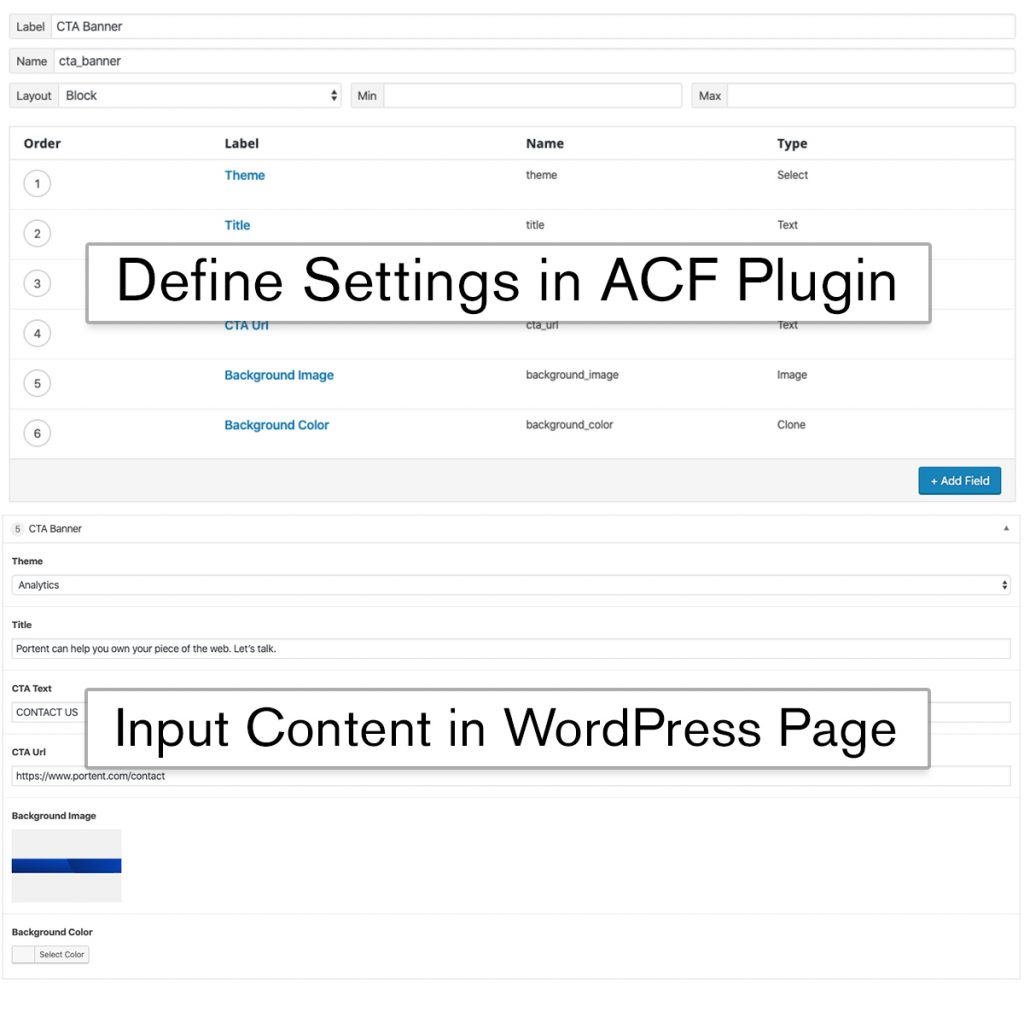

When Should You Use ACF?
Use cases for Advanced Custom Fields are vast. When starting a WordPress project, or looking to add additional functionality or new components, I would suggest reviewing the documentation on their website to see if ACF is the right plugin to use.
Autoptimize
Autoptimize is a WordPress plugin used to assist in website optimizations. It offers a multitude of options, including JavaScript, HTML, and CSS optimizations. It can also help with image lazy loading and image optimization through a content delivery network (CDN).
Why We Use Autoptimize
Autoptimize has a simple interface that makes selecting optimizations easy. It also has a more advanced interface option that you can select within the plugin settings. We tend to use this plugin because it does a great job of optimizing our sites, and it typically works well with other plugins. Autoptimize has an add-on plugin called Autoptimize criticalcss.com power-up, which helps with integrating critical-CSS styles for faster load times.
When Should You Use Autoptimize?
We recommend using Autoptimize for a majority of site optimizations such as slow page speed; JS, CSS, and HTML compression; or removing render-blocking assets by placing them in the correct areas of your markup.
Note: Before installing Autoptimize, we encourage users to run a site audit to see if you have any recommendations that would apply to Autoptimize. If you have questions on running a performance audit, check out our post, Ultimate Guide to Page Speed.
Yoast SEO
Yoast SEO is arguably one of the most downloaded WordPress plugins. Yoast SEO does a great job of simplifying SEO for everyday users.
Why We Use Yoast SEO
This plugin provides on-page SEO analysis within the WordPress page editor. It also lets you know whether the content on your page is readable and gives you tips to ensure your content makes sense to your users. Additionally, Yoast SEO has many user-friendly tutorials on how to use and set up the plugin for the best results.
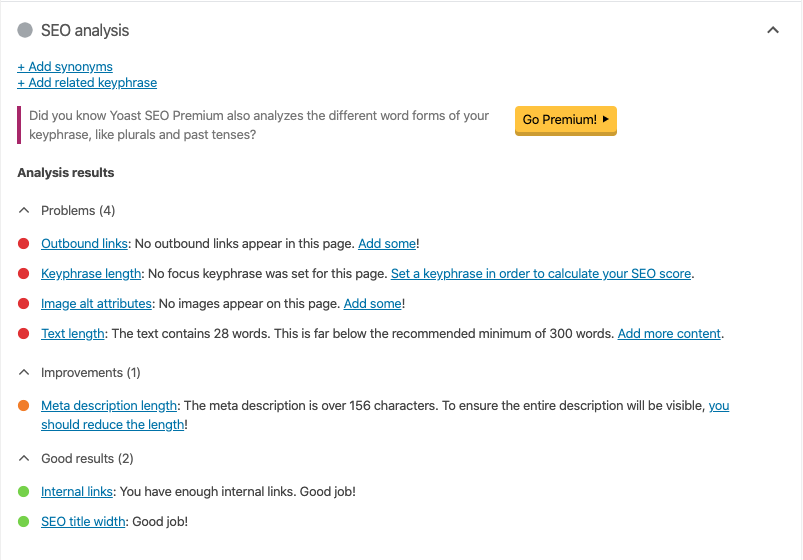

When Should You Use Yoast SEO?
Whether you’re just learning the ins and outs of search engine optimization, or you’re a seasoned user looking to further their knowledge of SEO, the Yoast SEO plugin is a great way to extend the standard SEO features in WordPress.
EWWW Image Optimizer
While we suggest optimizing images prior to uploading, EWWW Image Optimizer is an excellent tool for optimizing, resizing, and reformatting images that are already uploaded to your WordPress media library, as well as images you plan to upload in the future.
Why We Use EWWW Image Optimizer
We use EWWW Image Optimizer for image compression, and in some cases, for WebP image generation (WebP is a modern web image format developed by Google). EWWW Image Optimizer also generates various sizes of images based on predefined image sizes specified within the theme.
When Should You Use EWWW Image Optimizer?
We recommend EWWW Image Optimizer for anyone looking to increase their site speed by optimizing the images on their websites. Image optimization is one of the most important aspects of generating quality site speed scores. To see if you are suffering from slow scores due to heavy or oversized images, check out our post on maintaining site speed. The very first section of the post refers to image compression.
Safe SVG
Before jumping into the benefits of using the Safe SVG WordPress plugin, I want to give you some information on SVGs and why they can benefit you and your website. SVGs, or Scalable Vector Graphics, are XML-based vector images that can scale infinitely without becoming pixelated. Logos and icons are often created as SVGs. Aside from the fact that SVGs are scalable, SVGs also can be interactive and animated. They are also typically a much smaller file size than your typical PNG, JPG, or GIF, which means faster load times.
By default, WordPress doesn’t allow images to be uploaded as an SVG file format. The Safe SVG plugin remedies this and also filters uploads to look for potential security risks.
Why We Use Safe SVG
While there are snippets of code that can allow SVGs to be uploaded to WordPress, the SVGs won’t actually display in the media library once uploaded. Safe SVG will enable you to visually see your upload in the media library, as well as sanitize your uploaded SVG so you don’t open up doors to security vulnerabilities by uploading a malicious graphic to your site.
When Should You Use Safe SVG?
We recommend using the Safe SVG WordPress plugin for anyone who has SVG files that need to be uploaded to the WordPress media library.
To Recap
WordPress plugins have the ability to make your life so much easier when it comes to extending the functionality of your website. However, while the extended functionality can be appealing, it is important that you choose the right plugin for you.
Remember this checklist for choosing plugins:
- Check reviews
- Look at the number of active installs
- Determine the WordPress version testing
Always take the time to test plugins locally or on a staging/dev site. That way, you can ensure the plugin you choose isn’t going to cause you issues once installed on your live website.
And finally, there is such a thing as too many plugins! Excess plugins can affect your site speed. Before implementing one, consider whether or not you really need it, or if an existing plugin or a custom implementation could provide the same functionality.
The post Our 5 Favorite WordPress Plugins for Marketing appeared first on Portent.
The Post Black Friday World
We’re a few days from the actual Black Friday, but by now you’ve no doubt had roughly 500 emails announcing various Black Friday deals. Has this annual sale jumped the shark?

Black Friday Historically Speaking
There was a time that Black Friday was the most important shopping day of the year. Most professionals have the day after Thanksgiving off, and have spent the day with their families the day before. The 2 inch thick newspaper full of ads was the perfect escape from actually talking to our relatives. Throw in a few absurdly low priced items to get you to come in early, and you have a consumerist tradition in the making
Things are different now. Sure, we still want to avoid our relatives, but now we’re doing it on social media with the five inch computer in our pocket we call a smartphone. One reaction was to create Cyber Monday, but the vast majority of purchases still happen in person. Plus the black friday ads were often leaked well ahead of time, limiting the effect of the physical ad.
Black Friday becomes Novemeber
Reporters are all too happy to report on the leaked ads. It’s great for the attention that the deal gets, but it might actually hurt sales in the short term. After all, if you knew the TV you’d been eyeballing was going to be much cheaper if you waited, there’s no reason to buy it now.
Retailers did the obvious thing. They started selling at Black Friday prices well ahead of the actual day. It leaves the actual day for some deals that encourage odd, but newsworthy, behavior like camping out in front of the store. It’s still great for PR.
I’m left to wonder if the notion will lose its newsy appeal sooner than later. As news rooms suffer with dwindling resources, do they really want to send a crew on a holiday to interview a crazed consumer, just like they did last year, about the unbeatable laptop offer that’s worth spending the night in the cold to acquire? It comes across as an unpaid ad in so many ways. Online only outlets seem to rarely cover these sorts of events, and we suspect their traditional counterparts will do the same eventually.
It might go without saying that calling it a day doesn’t make sense any more, but the word Black Friday has taken on a life well beyond it’s literal 24 hour period. Any SEO worth their salt would tell you that people actually search that term way more than anything else you might try and call it. You can’t make people search they way you want them to, you have to use the terms they use.
Black Friday Backlash
At least one retailer has tried to set themselves apart from the rest. In a move reminiscent of Chick-Fil-A’s closed on Sunday policy, REI has decided to close on Black Friday. They’ve done it in a very on-brand way, encouraging people to use the day to actually get outside instead of shopping anywhere. It makes sense for them, and generated some positive coverage.
The truth is many more retailers should do the same, even if they aren’t associated with the outdoors. If your store isn’t about discounts, the sale seekers are just going to pass by.
Expanding the concept
Plenty of other days around Black Friday have been declared, some with very serious implications. Small Business Saturday is an encouragement (sponsored by American Express) to shop local. Decent idea, but honestly something that most do either do all the time or never. Sunday gets skipped, and then we get to Cyber Monday when the online outlets do their best version of DoorBusters.
Then we come to Giving Tuesday. This single day has been responsible for almost $250M in charitable donations in 2017 alone. With thousands of charities becoming part of this day, it’s now difficult to get individual coverage, but obviously worth the effort. It’s still a drop in the bucket compared to the billions spent on black friday and cyber Monday, but this day is showing explosive growth.
PR for Black Friday
If you’re reading this in 2019 you’re already far too late. Getting attention from news outlets on a day as well known as this takes a plan set in motion months ahead of the actual date. At this point a $99 laptop isn’t enough anymore. Doing these consumer days well requires a combination of creativity and strategy. The best strategy should leave a lasting impression, not just a loss leader item that’s soon forgotten.
Here’s a few ideas:
- Combine the whole event into one. If you’re a small business, use your small business Saturday proceeds to make a donation on giving Tuesday, for example. Nothing’s really a day anymore.
- Find Partners in the community. Work with some local restaurants for a “No Leftovers” Black Friday. Give a discount card with purchases that’s co-branded. I
- nvite a personality to the event. I still recall a sports store that had Picabo Street on Black Friday to sign autographs for a bit. You don’t need to book Britney Spears to get attention in most cases.
Don’t forget the tactical items either. Update your website with relevant information. Use a google post on your local listing as well. Consider getting influencers to promote your ideas around this. Even “micro influencers” make sense if they’re targeted well enough. It’s a big few days. Or a month. Or a season. Make the most of it.
The post The Post Black Friday World appeared first on The Future Buzz.
Why is the music industry bad at digital marketing?
In the early days of the Internet, it could be argued that the music industry was one of the best at digital. One of the first online open communities was Iron Maiden’s early site. MySpace was a massive success in no small part due to the musical presence there, launching careers like OneRepublic and eventually selling to Justin Timberlake. Of course, MySpace is now a footnote to Facebook’s history. So what happened?
Let’s start by looking at a couple of not so random musical websites.

There’s no denying that Taylor Swift is one of the biggest pop stars going right now. Her site features four options in the menu. Events, Video, Merchandise and Newsletter. Half of the links end up further down the page, leaving only Events and Merch with their own pages. So other than merch, there’s only two pages. The leading image is her album cover, and a close up of her album cover.
This makes for really bad SEO. If you search Taylor Swift Albums, for example, her own site is nowhere to be found. Roughly 30,000 people in the US do that search every month. Add in variants (discography) and it’s more like 150K a month. There’s no self controlled news, or anything else for fans for content unless you signup for that news letter. At least it’s kind of pretty.
Let’s look at the site that unseated her a the top of the charts. Tool.

This at least features a few more user paths and content to consume. The top of the site is dominated by a very extensive video loop, and there are links to more than just the latest video they’ve produced. But it’s virtually unreadable. If you can’t see it in the screen cap, it wouldn’t be surprising. Sure it captures the dark and brooding rock star thing, but doesn’t exactly make it usable.
Further down the page you’d find this article:

If you actually click on the read more you’ll see the cover of the magazine, but on the home page only the link can be seen. The link they posted is only a bare link with the facebook tracking parameter. In addition to looking quite ugly, it’s throwing off the metrics from where ever they took the link. It’s 2019, it’s not that hard to build a link with anchor text.
So bands don’t care about product sales or websites?
Somewhere in time, Napster came along and broke the industry. But it wasn’t really Napster, it was actually iTunes. And Pandora and Spotify Broke it further. Digital downloads and physical sales are only around 25% of music revenue any more. The remaining 75% is streaming. Rather than potentially thousands of retailers for sales, the bulk is now on a few platforms. Musicians care about SEO. It’s just that that S stands for Spotify rather than search. They’ve ceded control to the big streaming platforms and they know it.
The same might be said of ticket sales for concerts. It’s pretty much ticketmaster or secondary market places. The marketplace tacks on plenty of “convenience fees” which help the company but not the musician. Somewhere upwards of 20% on average for the convenience of buying a ticket in the only place you can get one.
That means the sites are left for superfans, not acquisition. It’s made opportunities for sites that specialize in lyrics or setlists, so you can find out which artist sings that song with a single line you remember. Google’s recognized this and is pretty good at matching the entity of a single line from a song to the actual song

What should a budding artist do?
We’ve looked at big artists, and poked holes in the work they’ve done. For every superstar, there’s thousands of struggling bands trying to make a go at music for a living. What should they do to get noticed?
We’d recommend some of the classic tactics for marketing and PR. Getting noticed in an industry like music is hard, but there are pros that expressly exist to help with this. People have to hear a song somewhere to start the interest cycle. The era of self made artists isn’t over, it’s just shifted to getting noticed on platforms like YouTube and Spotify from traditional radio and record shops. Social media can help too, as long as you’re making your music easy to share and find. Social media influencers are as real in this space as the recommendation engines. If anything the splintered landscape of digital has made the possibility to get discovered from anywhere, instead of just music towns.
And of course if you like this, don’t forget to check out my soundcloud.
The post Why is the music industry bad at digital marketing? appeared first on The Future Buzz.
8 Proven Ways to Build Your Email List
In this video I share 8 different ways to build an email list. Some of the tips will take a lot of work but I found that the more difficult it is to implement or create the …
Read More →Essential SEO Strategies to Get Organic Ranking from Your SEO Campaigns
 Experts suggest that 2019 paves the path for the introduction of new SEO strategies. If you implement these tricks well, then your SEO campaign can prosper. The primary aim of your SEO drive is to attract more traffic. These tactics can attract the attention of the target clients. With engaging content, you can compel the visitors to take action. Proper approach selection and application ensures a high rank on the SERP.
Experts suggest that 2019 paves the path for the introduction of new SEO strategies. If you implement these tricks well, then your SEO campaign can prosper. The primary aim of your SEO drive is to attract more traffic. These tactics can attract the attention of the target clients. With engaging content, you can compel the visitors to take action. Proper approach selection and application ensures a high rank on the SERP.
Why Opt For Organic SEO Strategies?
Organic SEO techniques take time. With inorganic SEO tricks, your website rank can go up in no time. But Google algorithm may detect these and slap a penalty on your portal. Thus, India SEO companies stress on organic SEO tactics. With these, you need not worry about Google penalties. If you implement organic SEO techniques well, Google algorithms add more value to the site. So, your portal rank can get a boost.
SEO Strategies to Ensure a Better Online Rank
If you possess some SEO knowledge, then you can select and implement new techniques without professional assistance. The e-books and online video tutorials may also come to your rescue. Here are some simple strategies, which save time and money but guarantee higher ranks on SERP.
Optimise Voice Search
By 2020, 50% of internet users may shift to voice search. Text and voice searchers have different attributes. If you do not desire to lose any clients, then optimise your site for this new tech. The visitors can save their time with voice searches.
Useable Links
5 Huge Warning Signs of a Bad SEO or Digital Marketing Agency
How to Maximize ROI on Your Ads
Internet Marketing Tips
Ensure Better User Experience
The design of your website impacts the visitor’s impression. Experts suggest that people do not want to waste time on a portal that confuses them. Your organic SEO campaign must guarantee a positive visitor experience. Layout and simple tabs make things easy for all visitors.
Use Backlinks

If your site has quality backlinks, you can get a high rank on the Google SERP. Backlinks guarantee a better position for your website. Paid links and blog comments cannot offer must help. Influencer marketing, good content and outreach assist you to earn good backlinks. Experts of any organic SEO company India suggest you add only a few backlinks for every page. It helps to maintain the balance on your website.
Improve Technical Optimisation
If you ignore the technical aspects, then your SEO campaign may not yield positive results. Technical optimisation is a vital aspect. It offers a solid foundation for your online presence. If you want to boost your local search exposure, then invest time in technical SEO. Schema mark-ups enhance the chances of more search results. Implement JavaScript Object Notation via your Google Tag Manager. It has a positive impact on your site’s visibility and CTR.
Measure SEO performance
SEO is an online marketing strategy that attracts target clients. When you get more visitors on the site, your traffic shoots up. It adds value to the portal. So, you must ensure that your strategy is on-point. SEO analytics and reporting are two essential tools at your disposal. You can use analytics and reporting programs to assess the SEO campaign performance. These programs offer in-depth information.
The reports highlight the weak links and where your SEO campaign needs improvement. Once you get the analytics report, you can reconsider the SEO strategies. Improve the current campaign so that you attain more clicks and traffic.
Do you want to run a successful SEO campaign? Do you want to implement best organic SEO techniques to up the site’s rank? Then contact the experts of SEO Services Consultants today. The experienced specialists can select the best strategies, which can increase traffic inflow on your portal.
Reference Link: http://www.articleted.com/article/175708/29141/5-Best-Organic-Optimisation-Strategies-to-Boost-Your-Site-s-Ranking
.
Futurelab joins forces with infinit.cx as an independent subsidiary
A couple of months ago, we announced that Futurelab had become a partner infinit.cx, a leader in complex contact centre solutions which has a long list of successful customer experience stories in Germany. Today, we are happy to announce that we have gone further in our partnership. From now Futurelab will be an independent subsidiary of infinit.cx GmbH.
Portent’s SEO Page Review Chrome Extension Gets a Refresh
Several years ago, the Portent SEO team developed a very useful Chrome Extension called the SEO Page Review. It was created by a very technically-minded SEO specialist and now Portent alum, Ken Colborn. Because it has been almost five years since its conception, I felt it was time for a refresh.
What is Portent’s SEO Page Review?
Portent’s SEO Page Review is a free Google Chrome extension available in the chrome web store. The lightweight extension reviews a website page for a number of on-page SEO factors and provides at-a-glance details and warnings around best practices for optimization.
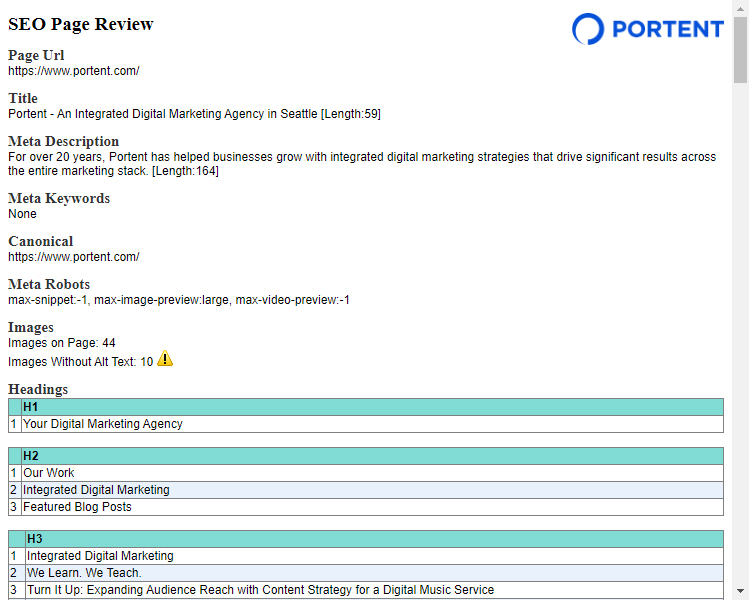

What Does it Analyze?
Our extension analyzes the source HTML of the page and provides details on the following SEO elements:
- Meta title, description, and keywords
- Meta robots tag
- Canonical tag
- Images on page, including a warning for images without ALT text
- Headings, with a warning if there is no H1 defined
- Facebook OpenGraph tags
- Twitter tags
- HREFLANG
- On-page links
- All other meta tags defined
- HTTP Headers
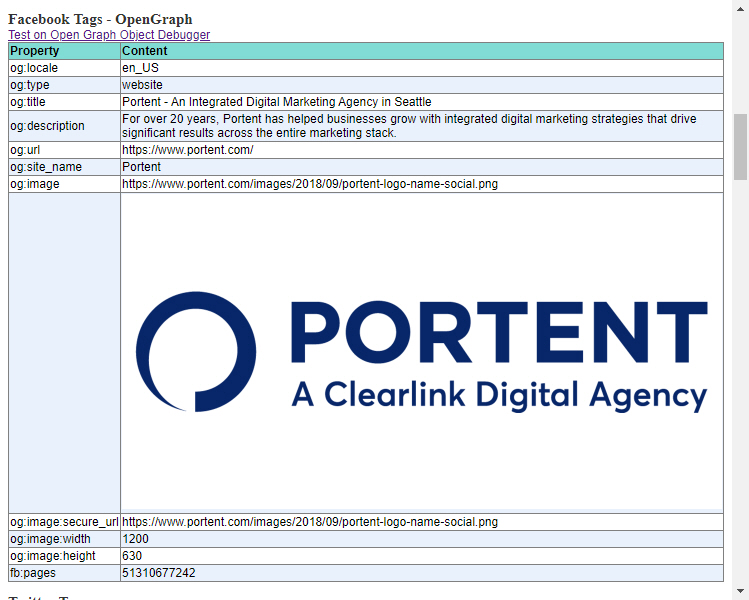

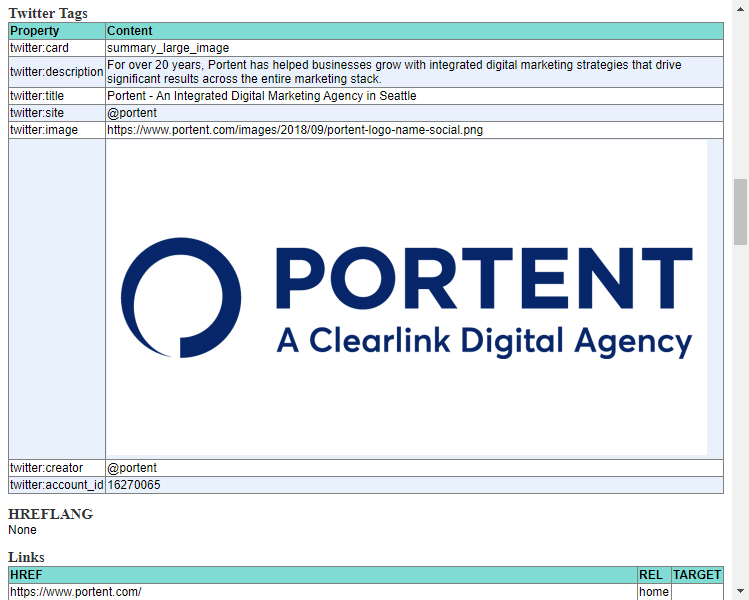

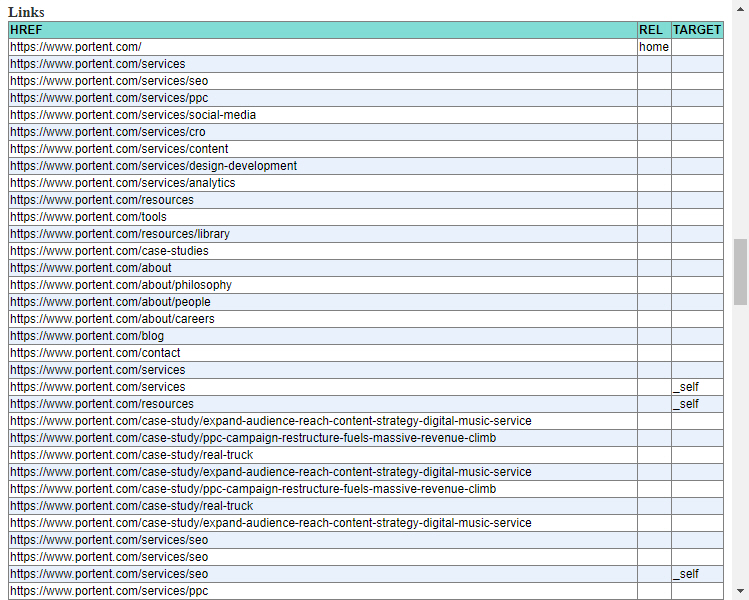

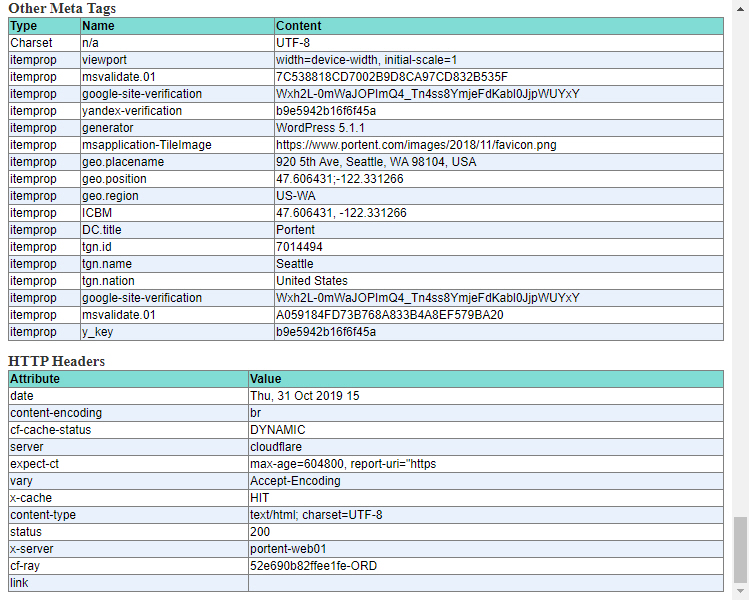

What’s New with the Refresh?
The refresh is relatively minor but addresses branding updates with our new logo, icon, fonts, and colors. Code cleanup and minor refactoring improve the already lightweight performance. We also added HTTP Headers analysis, as seen in the screenshot above.
Future Updates
We’re currently brainstorming new features and improved warnings and recommendations, but here are some more substantial items on our road map:
On load analysis and issue notification. Currently, the extension only executes its analysis when prompted, by clicking on the icon. We plan on implementing on-load functionality so users can be notified of potential issues before interacting.
Accessibility analysis. Accessibility concerns and the need for best practices continue to be pushed to the forefront of web applications. Portent plans on implementing on-page analysis of accessibility issues.
In addition to these, will continue to make ongoing improvements to the SEO Page Review extension for all you marketers out there. Cheers!
The post Portent’s SEO Page Review Chrome Extension Gets a Refresh appeared first on Portent.
Top 3 Reasons Why Real Estate Agents FAIL With Facebook Ads
Top 3 Reasons Why Real Estate Agents FAIL With Facebook Ads STEP #1 – Get My FREE Facebook Ads Mini Course Here …
Read More →5 Best Influencer Marketing Platforms to Grow your Brand Awareness
 By working with a person who has developed a strong reputation and has a blast of followers on social media, influencer marketing is a viable method to get the word out about a brand and help private companies focus on a particular audience. Influencer marketing platforms give an immediate method to organisations to work with influencers, assisting brands to manufacture active campaigns. Such platforms help influencers to hire social media marketers to adapt their social media accounts by helping organisations arrive at their objective clients and construct engagement and brand awareness.
By working with a person who has developed a strong reputation and has a blast of followers on social media, influencer marketing is a viable method to get the word out about a brand and help private companies focus on a particular audience. Influencer marketing platforms give an immediate method to organisations to work with influencers, assisting brands to manufacture active campaigns. Such platforms help influencers to hire social media marketers to adapt their social media accounts by helping organisations arrive at their objective clients and construct engagement and brand awareness.
What is an influencer marketing?
Influencer marketing is the procedure encouraged by an online influencer to associate a brand and its intended audience, with the point of getting consumer interest, prodding positive purchasing behaviour and continuing healthy client engagement. Influence marketing speaks to the advanced development of the traditional techniques for big-name underwriting and testimonial publicising. To keep up and develop their community of followers, online influencers start significant conversions and show expertise, empathy, and authenticity with their audience.
Organisations can utilise influencer marketing to accomplish different results: drive sales, contact new audiences, or present another brand or product to a particular consumer segment. Influencer marketing is among the best strategies for driving brand awareness, with the demonstrated ability to infuse pipelines with a sound number of new leads.
Best Influencer Marketing Platforms
For followers who have confidence in the judgment, authenticity, and domain expertise of their preferred influencers, each word expressed and move made by the influencer produces the correct sort of discussions. When an influencer advocates for a particular activity or supports a product, for instance, a significant number of their audience listens and reacts emphatically. Contrasted with traditional ads, an underwriting by an influencer is considered increasingly reliable and valid by the audience.
For organisations, partnering with the right influencer for all intents and purposes means accessing a friendly market and gaining mindshare among the influencer’s audience. In any case, influencer marketing achievement is rarely programmed. A confound between your brand, influencer, and their audience can reverse discharge and adversely impact all partners in the campaign.
Only one out of every odd marketing strategy works for each sort of audience either. That is the reason you need a well-planned strategy for hire social media marketer in influencer marketing to effectively convey the business results you are going for. Start by defining clear objectives and building up the methods (i.e., KPIs) by which you can evaluate/measure whether your campaign has accomplished those objectives sufficiently.
- CreatorIQ
- FameBit
- NeoReach
- Grapevine
- Heepsy
- Mavrck
- Scrunch






